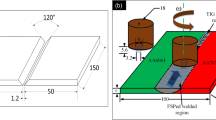Abstract
Surface striations with spacing equal to feed rate per rotation and banded structures in the weld nugget are some of the striking features of friction stir welding. However, their formation is still subject to some debate. This study contributes to comprehend their formation by evaluating the possible role played by the eccentricity of the tool during the welding of an aluminium alloy and using a plasticine as its analogue. The eccentric movement is visualized to generate both surface and bulk striations in plasticine. By voluntarily using non optimized welding conditions on aluminium, the material flow has been deduced and confronted with direct visual observations through high speed camera on plasticine. In the non closed section of the weld, two lobes each with thickness equal to feed rate per rotation were observed. First lobe corresponds to flow induced by the pin and tests on plasticine showed constant volume displacement per rotation for a given tool eccentricity. The second lobe is generated by material flow from under the shoulder back to the rear of the pin. The assembling or not of these two lobs behind the pin can explain some of the characteristic patterns observed in the weld nugget such as onion rings, oxide dispersions and cavities.










Similar content being viewed by others
References
Chen ZW, Pasang T, Qi Y (2007) Shear flow and formation of nugget zone during friction stir welding of aluminium alloy 5083-o. Materials Science and Engineering A
Zettler R, dos Santos JF, Donath T, Beckmann F, Lohwasser D (2006) Material flow in friction stir butt welded aluminium alloys. 6th Symposium on friction stir welding, St Sauveur, QC, Canada
Zettler R, Blanco AC, dos Santos JF, Marya S (2005) The effect of process parameters and tool geometry in friction stir welding of the alloys az31 and az61. Magnesium Technology, TMS
Chen HB, Yan K, Lin T, Chena SC, Jiang CY, Zhaob Y (2006) The investigation of typical welding defects for 5456 aluminum alloy friction stir welds. Mater Sci Eng, A 433:64–69
Dickerson T, Shercliff HR, Schmidt H (2003) A weld marker technique for flow visualization in friction stir welding. 4th International Symposium on Friction Stir Welding, Utah, USA
Colligan K (1999) Material flow behaviour durinf friction stir welding of aluminium. Weld Res Suppl 78:7
Lorrain O, Favier V, Zahrouni H, Lawrjaniec D (2010) Understanding the material flow path of friction stir welding process using unthreaded tools. J Mater Process Technol 210:603–609
Larsson H et al (2000) Joining of dissimilar al-alloys by friction stir welding. 2nd International Conference on Friction Stir Welds, Gothenburg, Sweden
Krishnan KN (2001) On the formation of onion rings in friction stir welding. Mater Sci Eng, A 327:246–251
Jene T, Dobmann G, Wagner G (2006) Oxide fragments in friction stir welds-distribution and effects on crack initiation. 6th Symposium on friction stir welding, St Sauveur, QC, Canada
Liechty BC, Webb BW (2006) The use of plasticine as an analog to explore material flow in friction stir welding. Journal of Materials Processing Technology
Kumar K, Kailas Satish V (2008) The role of friction stir welding tool on materialflow and weld formation. Mater Sci Eng, A 485:367–374
Gratecap F (2007) Contribution to friction stir welding process, Doctoral Thesis, Ecole Centrale de Nantes, France, 14 december
Gratecap F, Racineux G, Marya S (2008) A simple methodology to define conical tool geometry and welding parameters in friction stir welding. Int J Mater Form 1:143–158
Author information
Authors and Affiliations
Corresponding author
Rights and permissions
About this article
Cite this article
Gratecap, F., Girard, M., Marya, S. et al. Exploring material flow in friction stir welding: Tool eccentricity and formation of banded structures. Int J Mater Form 5, 99–107 (2012). https://doi.org/10.1007/s12289-010-1008-5
Received:
Accepted:
Published:
Issue Date:
DOI: https://doi.org/10.1007/s12289-010-1008-5




